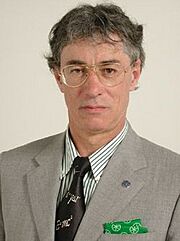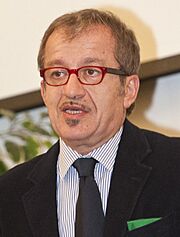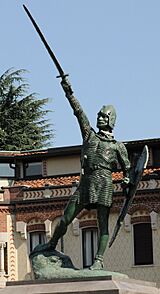Lega Nord facts for kids
Quick facts for kids <div style="padding-top:0.3em; padding-bottom:0.3em; border-top:2px solid Lua error in Module:European_and_national_party_data/config at line 227: attempt to index field 'data' (a nil value).; border-bottom:2px solid Lua error in Module:European_and_national_party_data/config at line 227: attempt to index field 'data' (a nil value).; line-height: 1;">
Northern League
Lega Nord
|
|
|---|---|
 |
|
| Leader | Matteo Salvini (last leader) |
| Federal President | Umberto Bossi |
| Federal Secretary | Igor Iezzi (commissioner) |
| Founded |
|
| Merger of |
|
| Headquarters | Via Bellerio, 41 20161 Milan |
| Newspaper | la Padania (1997–2014) |
| Youth wing | Young Padanians Movement |
| Membership (2013) | 122,000 |
| Ideology |
|
| Political position | Right-wing to far-right |
| National affiliation | Centre-right coalition (1994 and 2000–present) Lega (since 2020) |
| European affiliation |
|
| European Parliament group | |
| Associate party | Lega per Salvini Premier |
| Colours | <span style="background-color:Lua error in Module:European_and_national_party_data/config at line 227: attempt to index field 'data' (a nil value).; color:; border:1px solid #000000; text-align:center;"> Green |
| Anthem | "Va, pensiero" |
| Website | |
| Lua error in Module:European_and_national_party_data/config at line 227: attempt to index field 'data' (a nil value). |
|
Lega Nord (which means Northern League in English) is a political party in Italy. Its full name is Lega Nord per l'Indipendenza della Padania (Northern League for the Independence of Padania). It is a right-wing party that supports ideas like federalism, populism, and conservatism.
Before the 2018 general election, the party started calling itself just Lega (League). The party's founder was Umberto Bossi. Its most recent elected leader was Matteo Salvini.
Lega Nord was created in 1989 as a group of six regional parties from northern and central Italy. These parties wanted to change Italy from a single, central state to a federal state. This would give more power and control over taxes to the different regions, especially in the North.
At times, the party even wanted the northern part of Italy, which it called "Padania", to become a separate country. The party has also been against illegal immigration and has often been skeptical of the European Union.
Since 2020, the original Lega Nord has been mostly inactive. A new party, Lega per Salvini Premier (LSP), which was started by Salvini, has taken its place and is active all over Italy.
Contents
History of Lega Nord
How the Party Began
In the 1980s, some regional parties in northern Italy became popular. Liga Veneta from Veneto and Lega Lombarda from Lombardy won seats in the Italian Parliament. Their leader, Umberto Bossi, became a well-known politician.
In 1991, these parties and others joined together to officially form Lega Nord. They were inspired by the Lombard League, a group of northern Italian cities that fought for freedom in the Middle Ages. They felt that northern Italians were different from people in the rest of Italy and that the government in Rome was wasting their tax money.
The party quickly became popular. In the 1992 general election, it won 8.7% of the vote and became the fourth-largest party in Italy. This was a time when many Italians were unhappy with the main political parties.
Working with Berlusconi
In 1994, Lega Nord joined a coalition called the Pole of Freedoms with Silvio Berlusconi's new party, Forza Italia. They won the election, and Lega Nord members became ministers in the government for the first time. Roberto Maroni became the Minister of the Interior.
However, this government did not last long. Lega Nord and its partners had many disagreements. By the end of the year, Bossi decided to leave the coalition, which caused the government to fall. This led to some members leaving Lega Nord, but the party continued to be an important force in Italian politics.
The Idea of Padania
After the 1996 election, where Lega Nord got its best result ever (10.1% of the vote), the party announced a new goal: it wanted northern Italy to become an independent country called Padania.
To symbolize this, Bossi took water from the source of the Po River and poured it into the sea in Venice. The party even created a "Padanian Parliament" and a daily newspaper called La Padania. During these years, the party was very strong in many northern provinces.
However, this focus on separatism (the idea of becoming a separate country) caused more arguments inside the party. Some members left, and by the 1999 European election, the party's support had dropped to 4.5%. After this, the party focused more on devolution (giving more power to regions) instead of full independence.
Return to Government
In 2001, Lega Nord once again joined a coalition with Berlusconi, called the House of Freedoms. They won the election, and the party was back in government for five years. During this time, they controlled important ministries like Justice and Labour.
The party pushed for a major constitutional reform to create a federal system in Italy. However, this reform was rejected by voters in a referendum in 2006.
In the 2008 election, Lega Nord had a great result, winning 8.3% of the vote. It joined Berlusconi's fourth government, with four ministers. One of their main achievements was passing a law for "fiscal federalism", which aimed to give regions more control over their finances.
From Bossi to New Leaders
In 2012, Umberto Bossi resigned as leader after a party funding issue came to light. A group of three leaders, including Roberto Maroni, took over temporarily. Bossi was made the party's Federal President.
Later that year, Maroni was elected as the new Federal Secretary. Under his leadership, the party's structure was changed to give more autonomy to its regional sections. In the 2013 election, the party's support fell to 4.1%. However, in the same year, Maroni was elected President of Lombardy, one of Italy's most important regions.
The Leadership of Matteo Salvini

In December 2013, Matteo Salvini was elected as the new leader of Lega Nord. Salvini had a very critical view of the European Union and the euro currency. He began working with other nationalist parties in Europe, like the National Front in France.
Under Salvini, the party's focus shifted. He wanted to make the party popular not just in the North, but all over Italy. He created a sister party for central and southern Italy called Us with Salvini. The party's message became more focused on national issues, such as opposing immigration and the EU.
This new direction was successful. The party's support in opinion polls grew. In the 2018 general election, the party, running simply as "Lega", won 17.4% of the vote. It became the third-largest party in Italy and the leading party in the centre-right coalition.
The "Yellow-Green" Government
After the 2018 election, no single group had enough seats to form a government. Lega entered into a coalition with the Five Star Movement (M5S), the party that received the most votes. This government was called the "yellow-green" coalition, based on the parties' colors.
Salvini became Deputy Prime Minister and Minister of the Interior. The government was often described as the first "all-populist" government in Western Europe. During this time, Lega's popularity soared, reaching over 30% in opinion polls.
In August 2019, Salvini decided to end the coalition and called for a new election. However, the M5S formed a new government with the Democratic Party, and Lega went into opposition.
In December 2019, the party changed its rules to allow a new national party, Lega per Salvini Premier (LSP), to become active across all of Italy. The old Lega Nord was kept alive on paper but was effectively replaced by the LSP.
What Lega Nord Believes In
Lega Nord's main ideas have been federalism, regionalism, and protecting the traditions of Northern Italy. The party's goal was to change Italy into a federal state, where northern regions (Padania) could keep more of their tax money.
The party's views have changed over time. It started with some libertarian ideas but later adopted more socially conservative positions. It has also shifted from supporting Europe to being more Eurosceptic.
Key Ideas and Policies
- Federalism vs. Separatism: For many years, the party's main goal was federalism. In the mid-1990s, it switched to separatism, calling for an independent Padania. After 2001, it returned to focusing on federalism and devolution.
- Views on Europe: The party is often critical of the European Union, calling it a "superstate." Under Salvini, it strongly opposed the euro. However, other leaders like Roberto Maroni have supported a "Europe of the Regions."
- Immigration: The party has always taken a strong stance against illegal immigration. It has called for more controls to protect what it calls Italy's "Christian identity."
- Taxes and Economy: Lega Nord supports lower taxes, especially a flat tax system. It also wants to help small and medium-sized businesses and reduce government waste.
Support for the Party
Lega Nord's support has always been strongest in the northern regions of Italy. Its heartland is in Lombardy and Veneto.
In the 1996 election, it won over 25% of the vote in Lombardy and nearly 30% in Veneto. After a period of lower results, its support grew again under Salvini.
In the 2018 election, the party got its best-ever results, winning 32.2% in Veneto and 28.0% in Lombardy. It also gained many new voters in central and southern Italy. In the 2019 European election, it became the most popular party in Italy with 34.3% of the vote.
Images for kids
See also
 In Spanish: Liga Norte para niños
In Spanish: Liga Norte para niños













